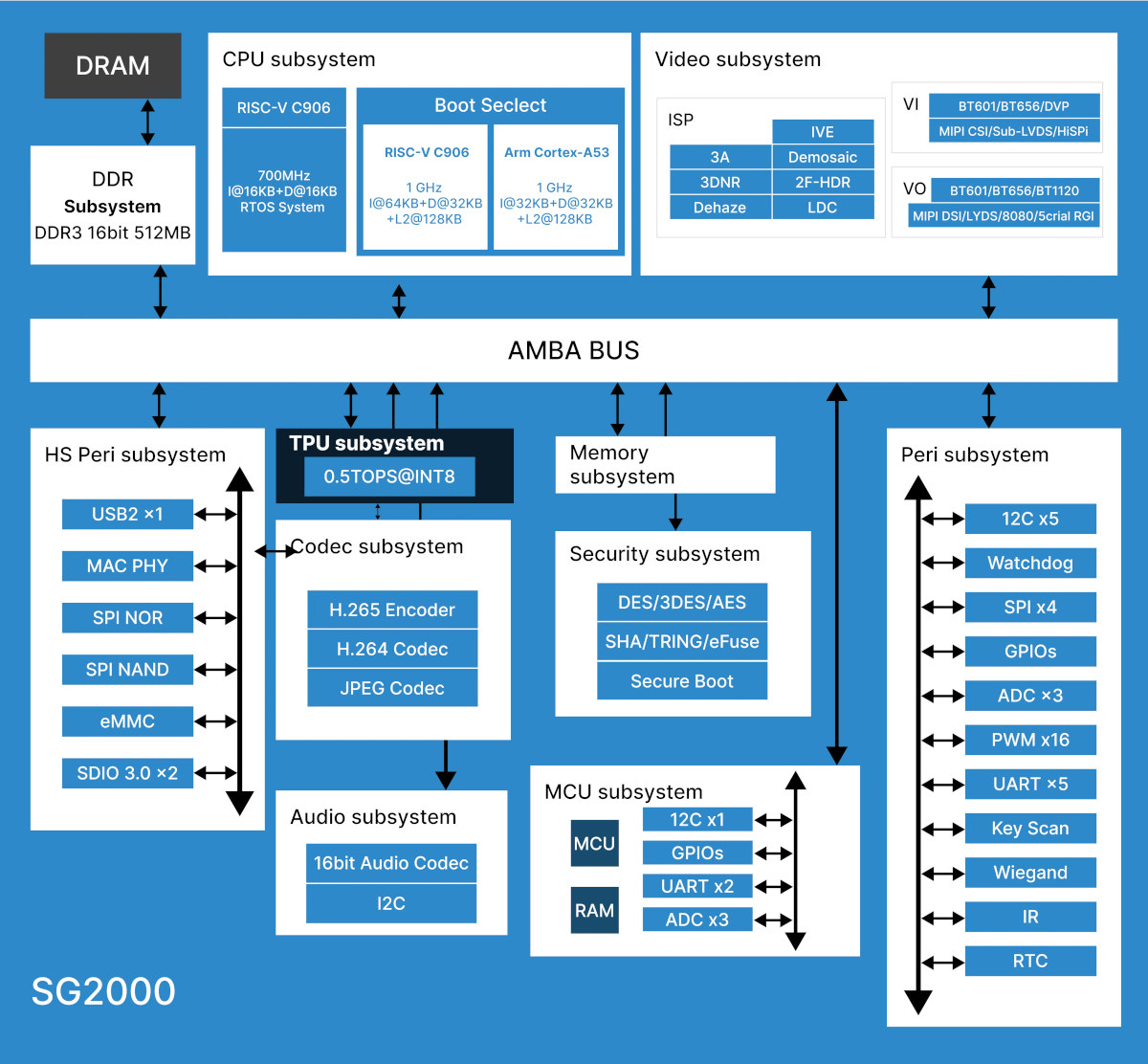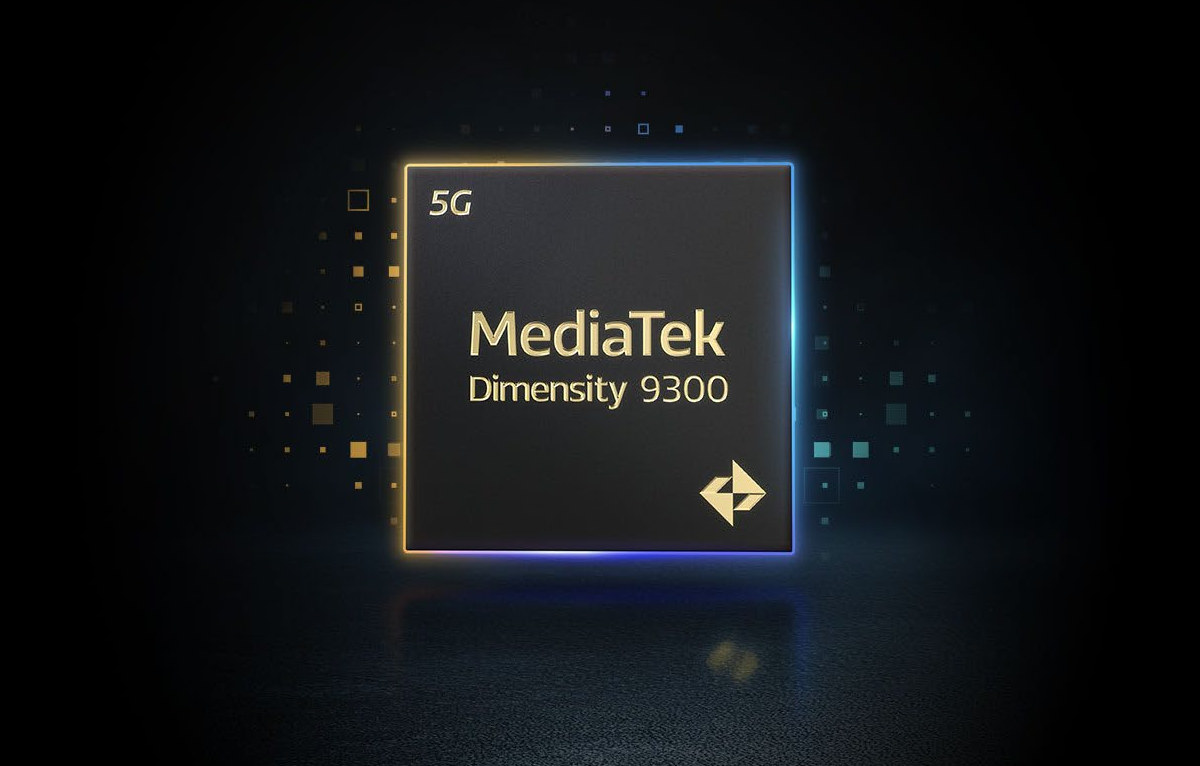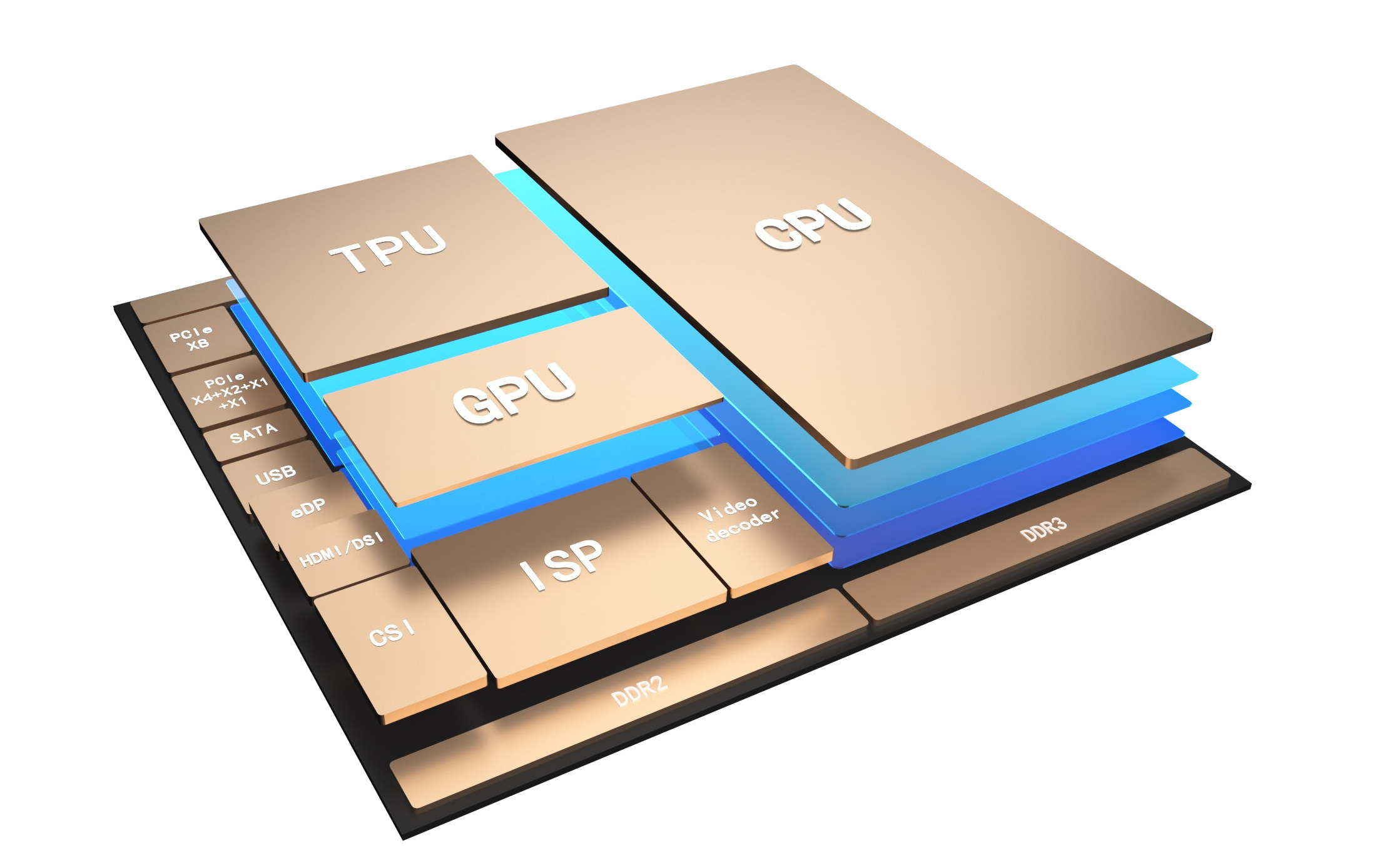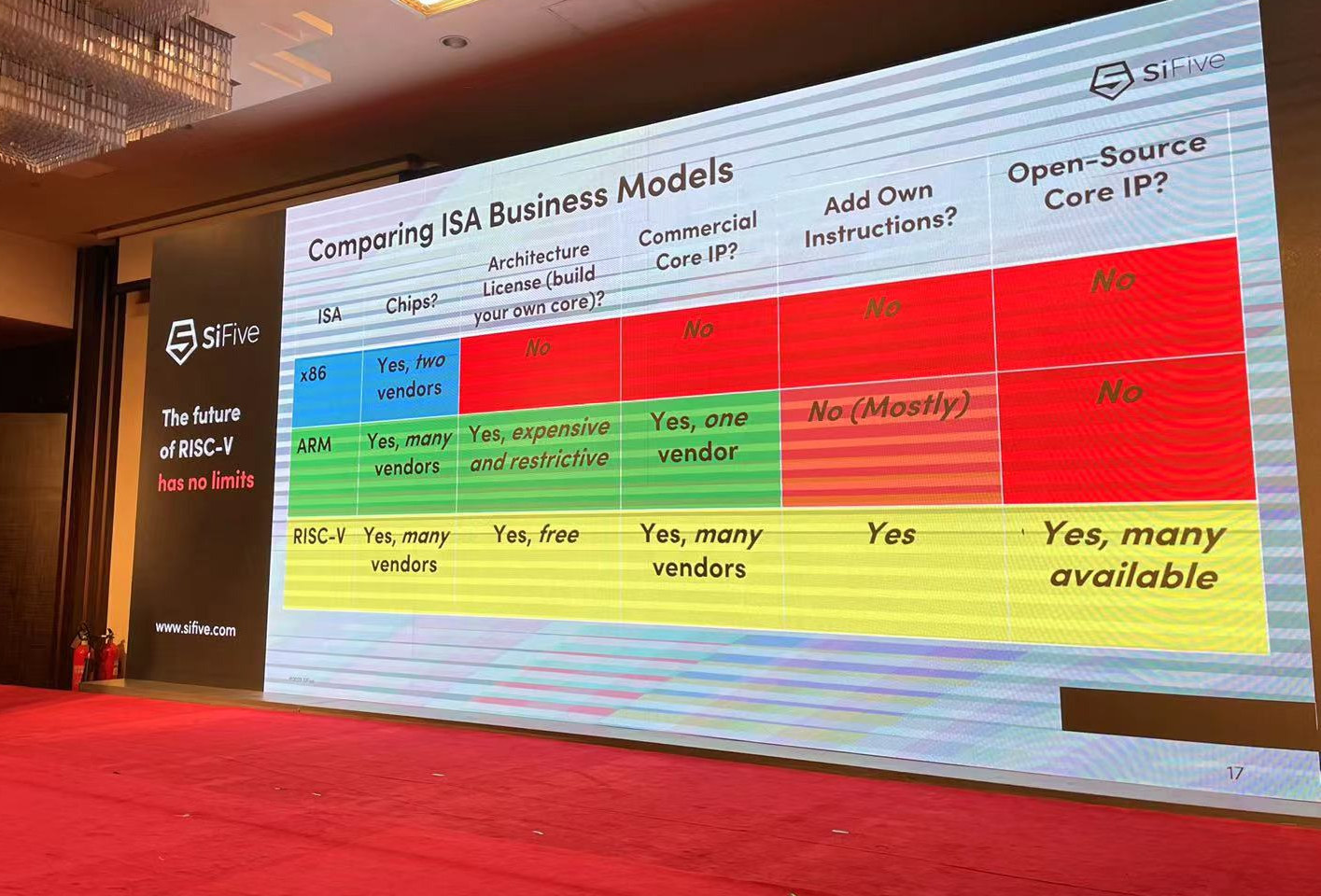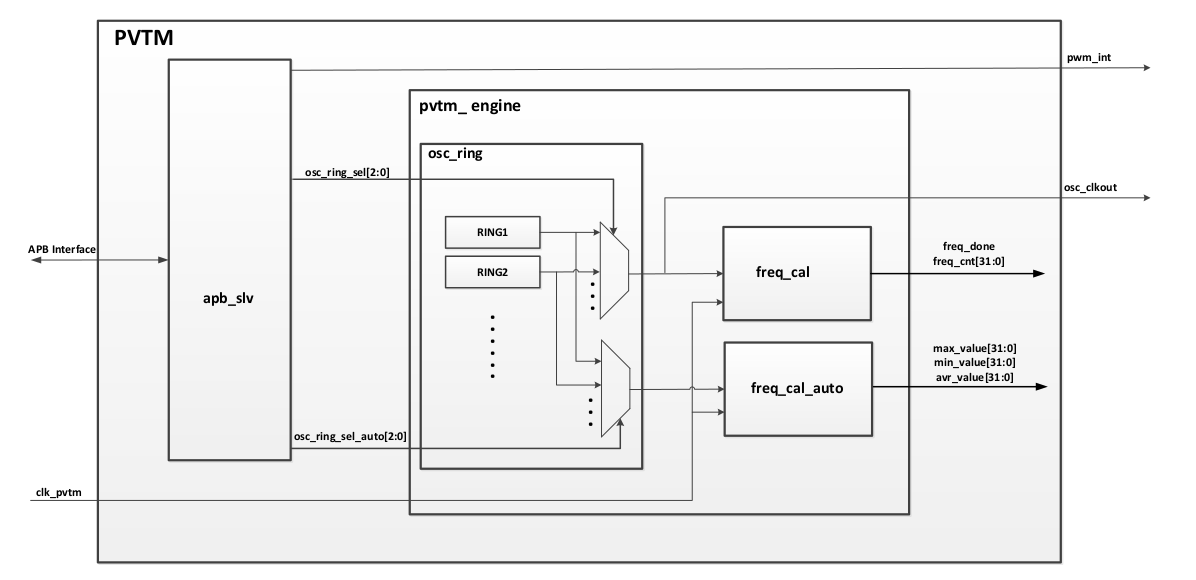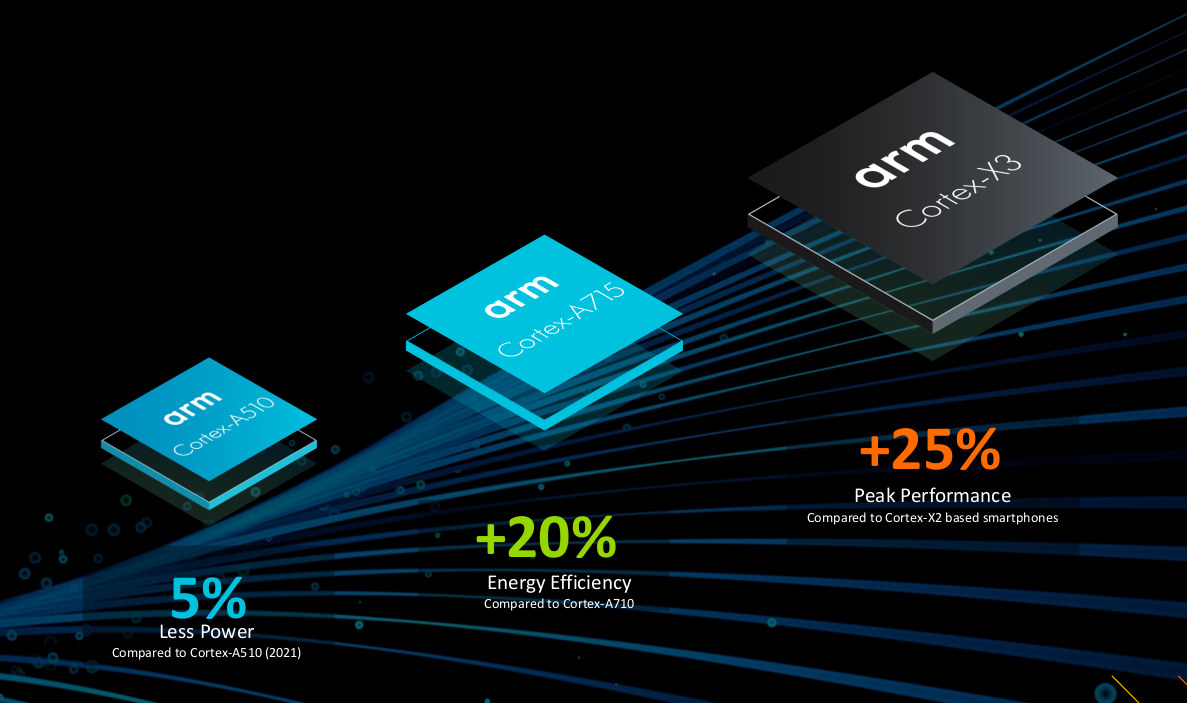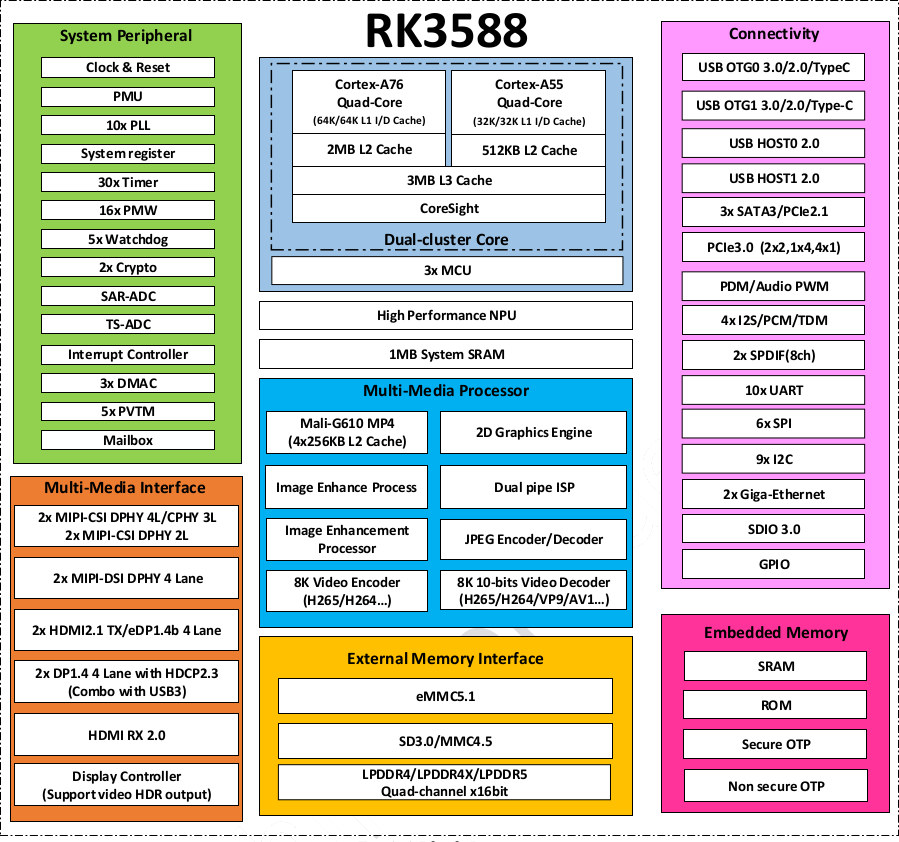SOPHGO SG2000 and SG2002 are new SoCs featuring a bunch of RISC-V and Arm cores capable of running Linux, Android, and FreeRTOS simultaneously, and to maximize the fun an 8051 MCU core is also in the mix along with a 0.5 TOPS (SG2000) or 1 TOPS (SG2002) AI accelerator. More specifically we have one 1GHz C906 64-bit core capable of running Linux, one 1GHz Arm Cortex-A53 for Linux or Android, another 700 MHz C906 RISC-V core for FreeRTOS, and a 300 MHz 8051-core for real-time I/Os, as well as 256MB or 512MB SiP DRAM. The chip is designed for AIoT applications such as Smart IP cameras, facial recognition, and smart home devices. SOPHGO SG2000/SG2002 specifications: CPU cores 1x C906 64-bit RISC-V core @ 1GHz 1x C906 64-bit RISC-V core @ 700MHz 1x Arm Cortex-A53 core @ 1GHz MCU – 8051 8-bit microcontroller core @ 25 to 300 MHz with 6KB […]
Renesas’ first 32-bit RISC-V CPU core delivers up to 3.27 CoreMark/MHz
Renesas has recently announced its first homegrown 32-bit RISC-V CPU core based on the open-standard instruction set architecture (ISA). This CPU core is compatible with Renesas’ e2 studio IDE and supports other third-party IDEs for RISC-V MCUs. According to Renesas, the CPU achieved a remarkable 3.27 CoreMark/MHz performance outperforming similar RISC-V architectures in this category. RISC-V, an open ISA, is rapidly gaining popularity in the semiconductor industry. Many MCU providers have formed joint investment alliances to expedite their RISC-V product development. Previously, Renesas released two CPUs developed by Andes Technology Corp: the R9A02G020, an ASSP EASY MCU for Motor Control, and the R9A06G150, an ASSP EASY MCU for Voice HMI, both based on RISC-V. Additionally, they have introduced the RZ/Five, a Linux-capable 64-bit RISC-V microprocessor family, and RH850/U2B, an automotive System on Chip (SoC). However, with the release of their new CPU, Renesas independently enters the RISC-V market, highlighting their […]
MediaTek drops efficiency cores in Dimensity 9300 Cortex-X4/A720 mobile SoC
MediaTek Dimensity 9300 is a premium octa-core 5G mobile SoC with two clusters of four Cortex-X4 cores and four Cortex-A720 cores, but doing without any Cortex-A520 efficiency core, plus the latest Arm Mali-G720 GPU, and a MediaTek APU 790 neural processing unit (NPU) capable of support generative AI and large language models (LLM) with up to 33 billion parameters. Arm invented big.LITTLE and then DynamIQ technologies in order to mix cores with different power efficiency and performance characteristics in order to improve power consumption. Their latest launches included the Cortex-X4 premium core, Cortex-A720 performance/big core, and Cortex-A520 efficient/LITTLE core, but MediaTek decided to do without the Cortex-A520 in the Dimensity 9300 which strikes me as odd for a mobile SoC where power efficiency is important for a long battery life. MediaTek Dimensity 9300 specifications: Octa-core CPU with DynamIQ 4x Arm Cortex-X4 at up to 3.25GHz 4x Arm Cortex-A720 up to […]
Sophgo SG2380 – A 2.5 GHz 16-core SiFive P670 RISC-V processor with a 20 TOPS AI accelerator
Sophgo SG2380 is an upcoming 2.5 GHz 16-core RISC-V processor based on SiFive Performance P670 cores and also equipped with a 20 TOPS AI accelerator using SiFive Intelligence X280 and Sophgo TPU that will find its way into a $120 desktop-class mini-ITX motherboard in H2 2024. The RISC-V processor also supports up to 64GB RAM, as well as UFS 3.2 and SATA 3.0 storage, comes with an Imagination GPU for 3D graphics and a VPU capable of 4Kp60 H.265, H.264, AV1, and VP9 video decoding, plenty of interfaces, and the system can manage locally deployed larger-scale LLMs like LLaMA-65B without the need for external NVIDIA or AMD accelerator cards. Sophgo SG2380 RISC-V SoC Sophgo SG2380 specifications: CPU 16-core SiFive P670 (RV64GCVH) 64-bit RISC-V processor @ up to 2.5GHz with RISC-V Vector v1.0, Vector Crypto Cluster configuration – 12x 2.5 GHz performance cores, 4x 1.6 GHz efficiency cores Full RISC-V RVA22 […]
SiFive unveils P870 high-performance core, discusses future of RISC-V
SiFive has just given a presentation at Hot Chips 2023 introducing the new high-performance P870 RISC-V core and its automotive equivalent the P870-A core, plus discussing RISC-V in general, its previous generation RISC-V cores, and what to expect going forward. SiFive has not officially announced the P870 and P870-A cores just yet, so most of the information we have from the English-speaking Internet is from ServeTheHome who managed to get some presentation slides, but this is also corroborated by various Chinese sources on Baidu and Guokr. SiFive P870 and P870-A The P870 and P870-A RISC-V cores are new cores from the SiFive Performance family compatible with the RISC-V RVA23 profile and succeeding the SiFive P670 core. The SpecINT2k6 benchmark reports 17 points per GHz on the P870 compared to 13.2 points per GHz for the P670 (comparable to the Arm Cortex-A78) or about a 29% higher performance at the same […]
What is PVTM? Or why your Rockchip RK3588 CPU may not reach 2.4 GHz
While the Rockchip RK3588 processor is advertised as reaching 2.4 GHz, not all RK3588 chips may achieve this frequency. The keyword is PVTM (Process-Voltage-Temperature Monitor), and we’ll try to explain why it does, and why some of the RK3588 processors may only be clocked at about 2.3 GHz, while others will run fine at 2.4 GHz. This all started with Rock 5B SBC debug party, where we noticed our boards did not reach the same frequency. Willy Tarreau noted the “pvtm” value was different between our boards: Willy’s board: (Cortex-A76 cluster 1 @ 2,304 MHz, cluster 2 @ 2,352 MHz)
|
1 2 3 4 5 6 7 |
# dmesg|grep cpu.*pvtm [ 2.606324] cpu cpu0: pvtm=1482 [ 2.606542] cpu cpu0: pvtm-volt-sel=3 [ 2.614206] cpu cpu4: pvtm=1722 [ 2.618389] cpu cpu4: pvtm-volt-sel=5 [ 2.626814] cpu cpu6: pvtm=1744 [ 2.630998] cpu cpu6: pvtm-volt-sel=6 |
CNXSoft board (Cortex-A76 cluster 1 @ 2,304 MHz, cluster 2 @ 2,304 MHz) :
|
1 2 3 4 5 6 |
[ 3.620281] cpu cpu0: pvtm=1490 [ 3.620376] cpu cpu0: pvtm-volt-sel=4 [ 3.627377] cpu cpu4: pvtm=1736 [ 3.631320] cpu cpu4: pvtm-volt-sel=5 [ 3.639103] cpu cpu6: pvtm=1732 [ 3.643069] cpu cpu6: pvtm-volt-sel=5 |
Thomas Kaiser (tkaiser) board: (Cortex-A76 cluster 1 @ 2,400 MHz, cluster 2 @ 2,400 MHz)
|
1 2 3 4 5 6 |
[ 3.117399] cpu cpu0: pvtm=1528 [ 3.117491] cpu cpu0: pvtm-volt-sel=5 [ 3.124529] cpu cpu4: pvtm=1785 [ 3.128495] cpu cpu4: pvtm-volt-sel=7 [ 3.136234] cpu cpu6: pvtm=1782 [ 3.140173] cpu cpu6: pvtm-volt-sel=7 |
For reference, CPU 0 to 3 are Cortex-A55 cores, CPU 4-5 are two Cortex-A76 cores (cluster 1), and […]
Arm unveils Cortex-X3 and Cortex-A715 Armv9 cores, improves Cortex-A510 efficiency
Besides announcing the new Immortalis-G715, Mali-G715, and Mali-G615 GPUs, Arm has also introduced the second-generation of Armv9 cores with the Cortex-A715 and Cortex-X3 cores with respectively a 20% energy-efficiency improvement (and smaller 5% performance uplift) over the Cortex-A710 core and a 25% peak performance boost against the Cortex-X2 flagship core. The announcement also includes a “refresh” of the Cortex-A510 core announced last year with a 5% improvement in efficiency and the same level of performance. The Cortex-X3 will also be used in (Windows 11) laptop processors with the single-thread performance improved by up to 34% in that case. Armv9 mobile SoC (Total Compute) in 2023 Future Armv9 flagship mobile SoC worked on this year, and released in 2023 should have a combination of Cortex-X3, Cortex-A715, and Cortex-A510 cores, an Immortalis-G715 GPU, a new DSU-110 “DynamIQ Shared Unit” that supports 50% more cores in CPU clusters (or up to 12 cores […]
Rockchip RK3588 datasheet available, SBC’s coming soon
We had most Rockchip RK3588 specifications so far for the long-awaited Cortex-A76/Cortex-A55 processor, but at today’s Rockchip Developer Conference 2021, more information surfaces with impressive CPU and GPU benchmarks, and the Rockchip RK3588 datasheet has just dropped from the sky directly into my laptop, as such document usually does. At least two single board computers are expected to soon follow from Radxa and Pine64. Rockchip RK3588 datasheet Since we have the datasheet, we can confirm some of the specifications of RK3588, and get additional details: CPU – 4x Cortex-A76 @ up to 2.4/2.6 GHz and 4x Cortex-A55 cores @ 1.8 GHz in dynamIQ configuration GPU Arm Mali-G610 MP4 “Odin” GPU with support for OpenGLES 1.1, 2.0, and 3.2, OpenCL up to 2.2 and Vulkan1.2 2D graphics engine up to 8192×8192 source, 4096×4096 destination AI Accelerator – 6 TOPS NPU 3.0 (Neural Processing Unit) VPU Video decoding 8Kp60 H.265, VP9, AVS2, […]


